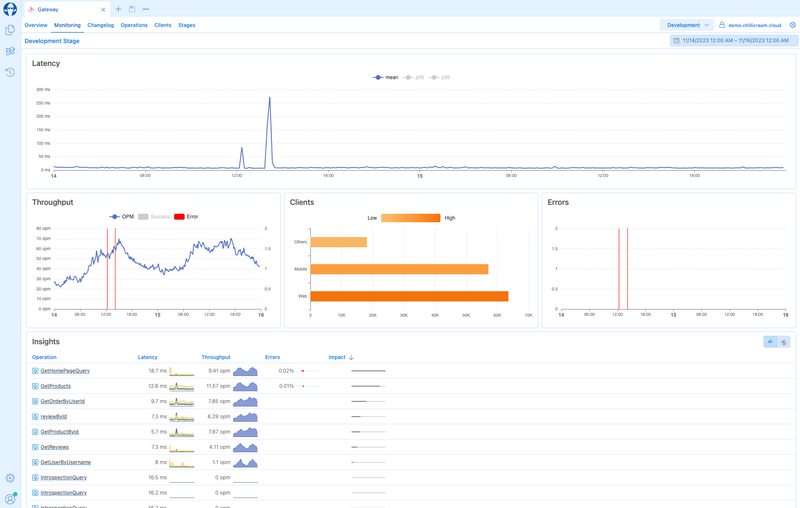 Banana Cake Pop can collect your open telemetry data and visualize your traces in the app.
With telemetry you can get a better understanding of how your application is performing and where you can improve it.
Banana Cake Pop can collect your open telemetry data and visualize your traces in the app.
With telemetry you can get a better understanding of how your application is performing and where you can improve it.
 It helps you to understand which resolver is impacting your system the most, which queries are slow and which are fast and deeply analyze each trace to your system.
It helps you to understand which resolver is impacting your system the most, which queries are slow and which are fast and deeply analyze each trace to your system.
Connect your service to the telemetry system
All the reporting is done on a per API basis. An api represents one of your deployments. To monitor you services you need to create an API in banana cake pop. The api needs to be from type "Api Service" or "Api Gateway".
To install the Banana Cake Pop services, run the following commands in your project's root directory:
dotnet add package BananaCakePop.Servicesdotnet add package OpenTelemetry.Extensions.Hostingdotnet add package OpenTelemetry.Instrumentation.AspNetCore
After installing the package, you need to configure the services in your startup class. Below is a sample implementation in C#:
public void ConfigureServices(IServiceCollection services){ services .AddGraphQLServer() .AddQueryType<Query>() .AddBananaCakePopServices(x => { x.ApiKey = "<<your-api-key>>"; x.ApiId = "QXBpCmc5NGYwZTIzNDZhZjQ0NjBmYTljNDNhZDA2ZmRkZDA2Ng=="; x.Stage = "dev"; }) .AddInstrumentation(); // Enable the graphql telemetry
services .AddOpenTelemetry() .WithTracing(x => { x.AddAspNetCoreInstrumentation(); x.AddBananaCakePopExporter(); });}
Tip: Using Environment Variables
Alternatively, you can set the required values using environment variables. This method allows you to call
AddBananaCakePopServiceswithout explicitly passing parameters.
BCP_API_KEYmaps toApiKeyBCP_API_IDmaps toApiIdBCP_STAGEmaps toStageC#public void ConfigureServices(IServiceCollection services){services.AddGraphQLServer().AddQueryType<Query>().AddBananaCakePopServices().AddInstrumentation(); // Enable the graphql telemetryservices.AddOpenTelemetry().WithTracing(x =>{x.AddAspNetCoreInstrumentation();x.AddBananaCakePopExporter();});}In this setup, the API key, ID, and stage are set through environment variables.
Monitoring Dashboard
The monitoring dashboard in Banana Cake Pop offers various metrics and visualizations to understand your service's performance better.
Changing the time range
 You can change the time range of the dashboard by clicking on the time range selector in the top right corner of the dashboard.
You can either customize the time range or select one of the predefined ranges.
You can change the time range of the dashboard by clicking on the time range selector in the top right corner of the dashboard.
You can either customize the time range or select one of the predefined ranges.
Latency
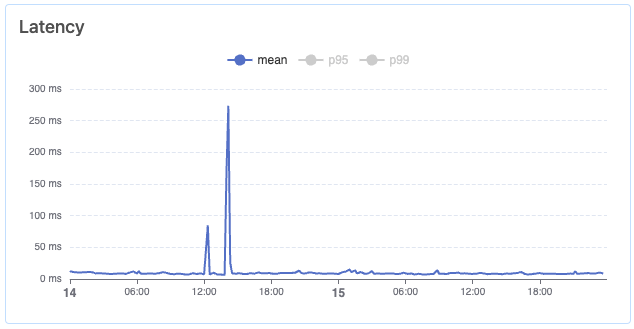 The latency graph shows the average latency of your service over time. You can also see the 95th and the 99th percentile of the latency.
The latency graph shows the average latency of your service over time. You can also see the 95th and the 99th percentile of the latency.
Throughput
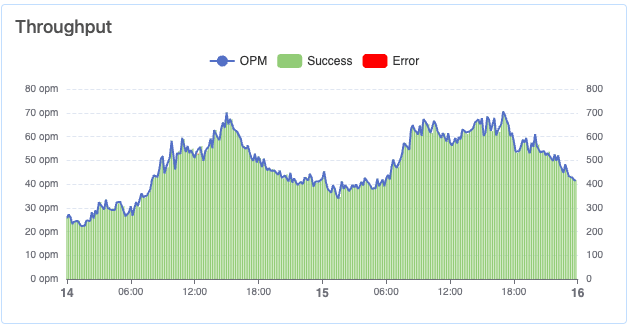 The throughput graph shows you the operations per minute over time. You can see how many operations are executed on your service and how many of them failed.
The throughput graph shows you the operations per minute over time. You can see how many operations are executed on your service and how many of them failed.
Clients
 You can track how many requests are done by each client. This helps you to understand which client is impacting your system the most.
To track this, your clients need to send two headers with each request:
You can track how many requests are done by each client. This helps you to understand which client is impacting your system the most.
To track this, your clients need to send two headers with each request:
GraphQL-Client-Id- The id of the client. You can get the id from the client by executionbarsita client listin your terminal.GraphQL-Client-Version- The version of the client
Errors
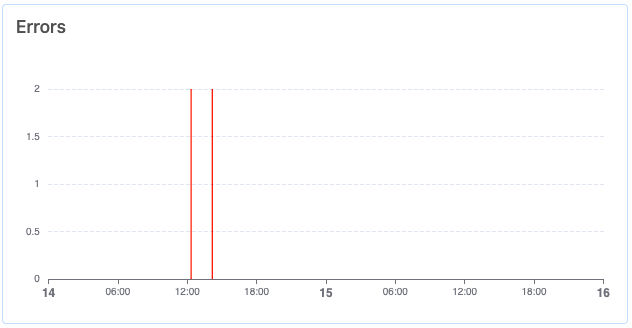 Shows you the number of operations with errors over time.
Shows you the number of operations with errors over time.
Insights
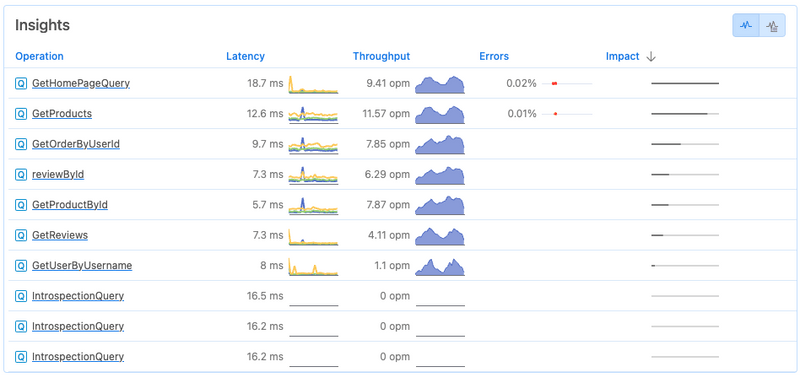 This insights show you a list of executed operations. You can see the latency, the throughput and also how many percent of the operations had errors. You also have a column impact, which will help you to understand which operations are impacting your system the most. You can sort the columns by clicking on the column header.
This insights show you a list of executed operations. You can see the latency, the throughput and also how many percent of the operations had errors. You also have a column impact, which will help you to understand which operations are impacting your system the most. You can sort the columns by clicking on the column header.
By clicking on an operation, you can see the telemetry information about the operation and it's traces.
 On the top right corner you can change from the operation insights to the resolver insights view.
On the top right corner you can change from the operation insights to the resolver insights view.
Operation Dashboard
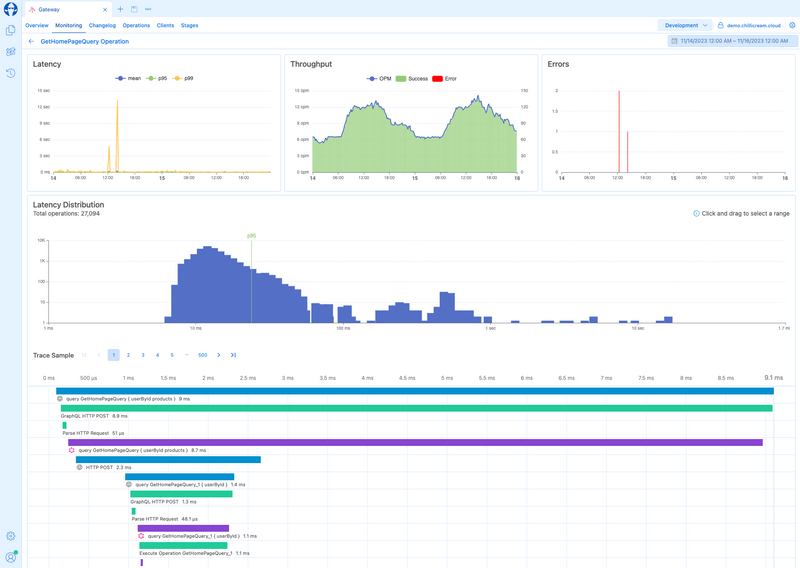 You can drill down into the telemetry information of a single operation by clicking on it in the insights view.
You can drill down into the telemetry information of a single operation by clicking on it in the insights view.
Latency Error and Throughput
Theses graphs show you the latency, error rate and throughput of the selected operation over time similar to the graphs on the monitoring dashboard.
Latency Distribution
 This graph shows you the distribution of different traces of the selected operation. This way you can quickly see outliers and understand how the operation is performing.
This graph shows you the distribution of different traces of the selected operation. This way you can quickly see outliers and understand how the operation is performing.
 You can also select a time range in the graph. This selection will impact which traces are shown in the trace table. You can for example select the slow operations on the right and inspect why they are slow.
You can also select a time range in the graph. This selection will impact which traces are shown in the trace table. You can for example select the slow operations on the right and inspect why they are slow.
Traces
 On the very bottom of the page you see sample traces of the selected operation with all of the spans.
On the very bottom of the page you see sample traces of the selected operation with all of the spans.
If you click on a trace, the sidebar will show additional information about the trace including all the attributes of it.
